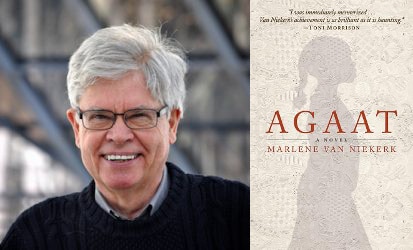In an article that appeared recently on the website of Public Books titled ‘The Triumph of Afrikaans Fiction’ STIAS fellow Derek Attridge recounts his reading of well-known South African author Marlene van Niekerk’s novel Agaat. The opening paragraphs of the article appear below, followed by a link to the full article.
The Triumph of Afrikaans Fiction, by Derek Attridge
I’m reading one of the great novels of our time. I’m doing so slowly because it’s in Afrikaans, and although I learned the language for many years in South African schools, that was a very long time ago. The novel is Agaat, its title both a proper name (Agatha) and the Afrikaans word for “agate”; the author, Marlene van Niekerk, is a leading Afrikaans poet as well as novelist and short-story writer.1 Luckily, I have at hand the superb translation by Michiel Heyns, the version in which I first encountered the novel.2 A film of Agaat is said to be in preproduction, but however successful it turns out to be, it will be able to convey only a glimmer of Van Niekerk’s achievement.

The origins of Afrikaans lie in the contact at the Cape of Good Hope among Dutch settlers, slaves from the Dutch territories in the East, and indigenous peoples, a creolization process that began in the late 17th century. A standard version of Afrikaans was established during the last third of the 19th century, partly in opposition to the dominance of English, and in 1925 it displaced Dutch as one of South Africa’s two official languages. With the triumph of the National Party in 1948, it became the language of government and thus of apartheid, a stigma that still attaches to it in many minds.
However, of the 7 or 8 million people who speak Afrikaans as a first language, more than half are what the apartheid classifiers termed “coloured” (that is, “mixed race”) peoples, whose variety of the language, sometimes called “Kaaps,” was dismissed by the upholders of the idea of a “pure” Afrikaans during the apartheid era.3 There is not yet a substantial body of literature in Kaaps, in spite of the pioneering work of Adam Small, but the recent poetry of Nathan Trantraal and Ronelda Kamfer shows how rich a resource the language offers.4
Read further at PublicBooks.org
Endnotes:
- Agaat was originally published, by Tafelberg (South Africa), in 2004. The title is pronounced with the /x/ sound of Bach.
- South African publishers Jonathan Ball brought out the Heyns translation in 2006; Little, Brown UK published it as The Way of the Women in 2007; the current reissue, by Tin House, reverts to the original title.
- The most recent census took place in 2011, when the number of first-language Afrikaans speakers recorded was a little under 7 million. Numbers have undoubtedly grown significantly since then. I use the South African spelling of “coloured” to distinguish it from American usage of the term with a different meaning.
- For 60 years until his death in 2016, Small was the preeminent writer using Kaaps, producing memorable work in poetry, drama, and fiction. Trantraal’s best-known collection is Chokers en survivors (2013); Kamfer’s is Noudat slapende honde (2008).
Derek Attridge presented a seminar during his STIAS residency on translating works of literature.
